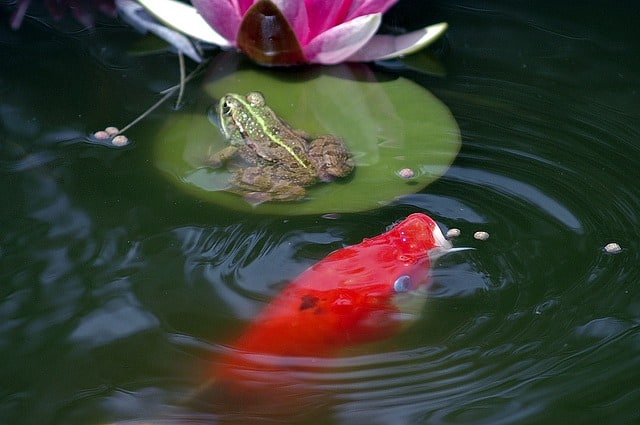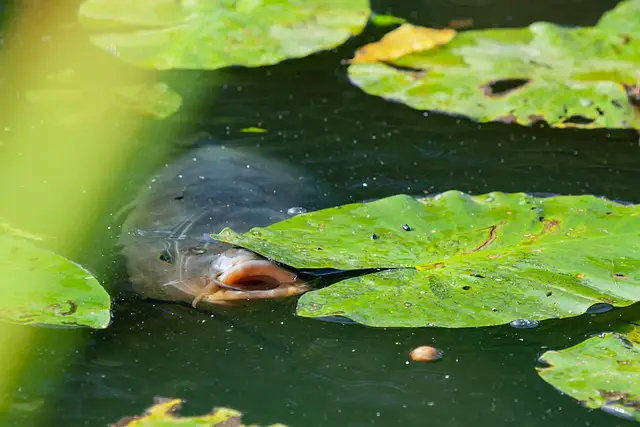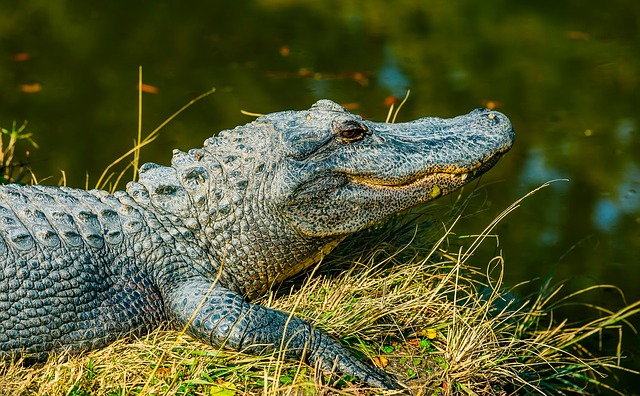Whenever I go to a pond and garden center, I always see channel cats so I was really tempted to let them swim around with my koi. In some cases, they can actually be decent pond mates.
The problem, as I found out the hard way, is that the domestic albino variants you usually see in fish stores can grow to around 5 feet in length. Some material that I’ve read suggests they can get even bigger depending on what kind of food is available for them in your pond.
At that size, they’re pretty free to swallow small and even medium-sized koi fish whole, which is exactly why you’ve got to be careful letting them live together.
So, can channel catfish live with koi? Yes if they are similar in size or the koi are larger. Full-size channel catfish that are several feet in length should not be introduced into a koi pond. Instead, it’s best to get similar-sized fish and let them grow up together.
Will Koi Eat Them?
I don’t normally see huge koi for sale in pond supply places, so it’s hard to imagine your garden variety koi fish eating a channel cat. It’s theoretically possible if your fish gets large enough or you’re trying to raise baby catfish.
Nearly every pond and garden expert I’ve come across cautions against leaving adult koi with immature other fish because of the possibility of the smaller ones being viewed as a snack.
Will the Catfish Eat My Koi?
This is a much bigger concern, simply because the fish involved are much bigger! An adult channel catfish can grow to lengths of 5 feet or even more, so they could theoretically swallow small koi whole.
Some garden experts I’ve followed consider the channel catfish to be a so-called questionable pond mate for koi, much like the more aggressive bullhead catfish and the very toothy Japanese catfish.
List of Catfish that can Live in a Koi Pond
Out of true catfish, there’s generally four species that cooperate well with koi fish:
- Columbian Shark
- Iridescent Shark
- Bumblebee Catfish
- Bandit Cory Catfish
If you’re like me, then those first two names really threw you off. While they’re called sharks by most pet stores, both the Columbian and the Iridescent are actually catfish that live relatively well alongside koi if you give them enough room.
In general, it seems that they survive well on the same food, but you want to keep your fish healthy. If one of these cats gets too large, then it might consider a sickly koi to be a nice snack!
Fortunately, if you’re keeping fish from these four species there are a few ways you can reduce the risk of a fish between them and your koi.
How to Stop Koi and the Other Fish from Fighting
Overstocking is probably the number one cause of fish fighting with each other. If you have too many in one pond, then even your koi will fight with each other.
I’ve found that most people recommend a ratio of 10 gallons of water for each inch of fish you have stocked together. Add up the length of every fish you plan on putting it and then divide this number by 10 to find out how much water you need for all of them.
If you’re just starting with young fish, then keep in mind that they’re probably going to grow a lot bigger so you might want to have even less than this until you’re sure how big they’re going to get.
Can channel catfish live in a pond?
Yes, if you maintain the proper balance. Channel catfish are bottom feeders which primarily eat invertebrates on the bottom of a body of water. The ponds that these fish will inhabit will have to be at least 2 feet deep for them to survive–but don’t let that fool you!
These relatively small fish grow up to 11 inches in length and weigh more than 10 pounds, so it’s imperative that they have enough oxygen in the water before they’re introduced (or brought into) your pond’s ecosystem.
How long can a catfish live?
Catfish live for an average of 5-20 years. The Mekong catfish found in the Mekong River of Southeast Asia was found to live up to 60 years and weigh over 440 pounds. The maximum lifespan for catfish is unknown because some catfish in nature are documented to reach lengths over 15 feet and weigh over 100 pounds.
Koi belongs to a family of fish called Cyprinidae and are descendants of carp. Catfish belongs to the family Ictaluridae. Kois and catfish are related through their superorder, Ostariophysi, and their class which is Actinopterygii.
How Big Will Channel Catfish Get?
The world record channel catfish weighed 38.15kg (84lbs) and was caught in the Alabama River. Channel catfish live slow but long lives (over 20 years!), and average around 5-6 pounds for rough fish that have been targeted by anglers, while females can exceed 10 pounds when pregnant or carrying eggs about to hatch.
However, there are occasional individuals of significant size that make it possible for the lucky angler to land one exceeding 84lbs!
How big can koi fish get?
Most experienced keepers I’ve seen say that female Jumbo koi can grow to around 30 inches long and weigh over 20 pounds. Japanese decorative koi, however, don’t usually get much longer than 25 inches.
If you’re worried about the amount of room you have, then look into smaller domestic varieties. Most domestic koi usually stop growing after they get around a foot long.
Channel catfish food
To continually grow channel catfish to the desired size, you should feed your fish pellets at least 2 times a day. Insects and larvae are one very important food source for them, so you can feed them some live food that will stay alive between water changes. Earthworms work well because they’re easy to get at bait shops and supermarkets. You should also encourage the growth of natural aquatic vegetation.
What Should I Feed Them?
While I’ve tried a few different foods, it seems like a piece of advice given to me at a larger pet supply place has worked the best. Regular floating fish food that has around 28-36 percent protein is a good fit for catfish.
You could even go with a food that provides more protein than this. In many cases, koi and channel cats will enjoy the same flake food products.
Don’t overfeed them, but make sure there’s plenty for all your fish to avoid fights.
How Often to Feed Your Fish
Judging by what I’ve read from aquaculture specialists, you’ll want to feed newly hatched channel cats much more than adult ones. Assuming that your fish is developed, you’ll probably want to feed them around 4-6 times every week.
Young fish will need food several times a day. Once the temperatures start to drop, catfish tend to eat much less.
You might want to switch to a high-protein sinking feed once it drops under 50°F or so.
How Long and Deep Should the Pond Be?
My first pond was way too small, and I figure that a lot of people probably start this way. When I was having trouble, I found that several experienced koi and catfish aficionados recommended ponds to be no smaller than 1,500 gallons.
This means you’ll want it to be at least four feet deep if it’s dimensioned at somewhere around 7×8 or so. This gives your koi and catfish plenty of space to grow.
Depending on how many fish you have, you might want to have a pond as large as 15,000 gallons.
How to Help them Through Winter
Start reducing the amount of food you give them when you notice that they slow down with feeding. Your pond might soon start to freeze over, which could actually protect your koi.
Many experts have recommended not feeding at all during the coldest months. Those who find that their ponds are icing over completely may want to aerate the top, but it’s probably a good idea to leave at least some ice cover to help regulate the pond.
Those who live in warmer climates that have milder winters may need to feed once or twice a week during the winter months, but it’s still not the best idea to feed your fish whenever the temperature drops below 50° and stays there for an extended period of time.
Hi, I’m John Stephens, chief editor and writer for Totalgardener.com. I’ve been gardening and raising animals for over 15 years starting with a small backyard plot in Northern Virginia where I grew corn, potatoes, squash, and using a high mulch technique called the Ruth Stout Method. I also raised ducks and small mammals for meat and eggs in a movable pen similar to the ones used by Joel Salatin. I later moved to Colorado where I experimented with growing greens using aquaponics inside. I eventually added a microgreens setup and home sprouting operation. I’m excited to share everything I’ve learned plus more from the other local gardening and animal raising experts I know.



